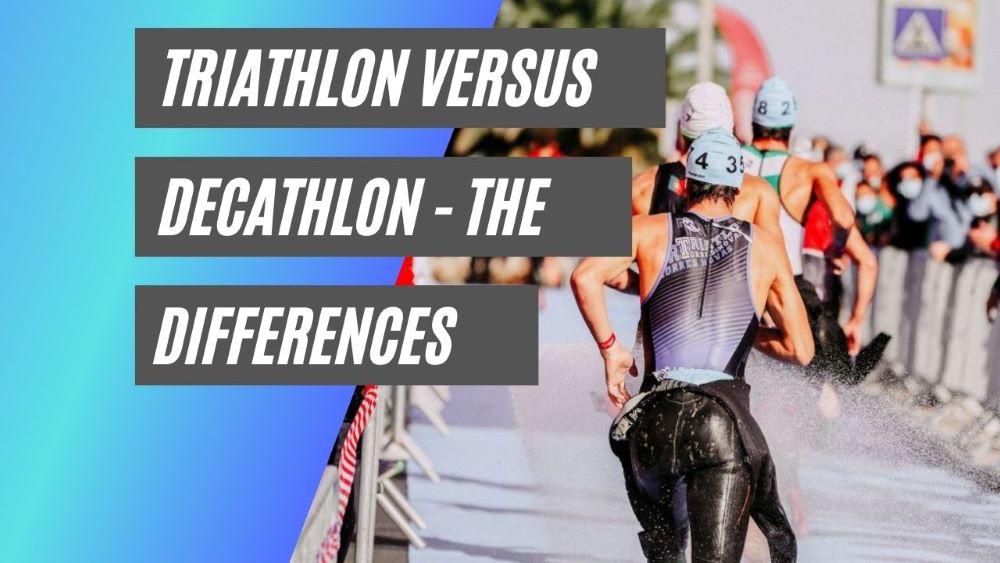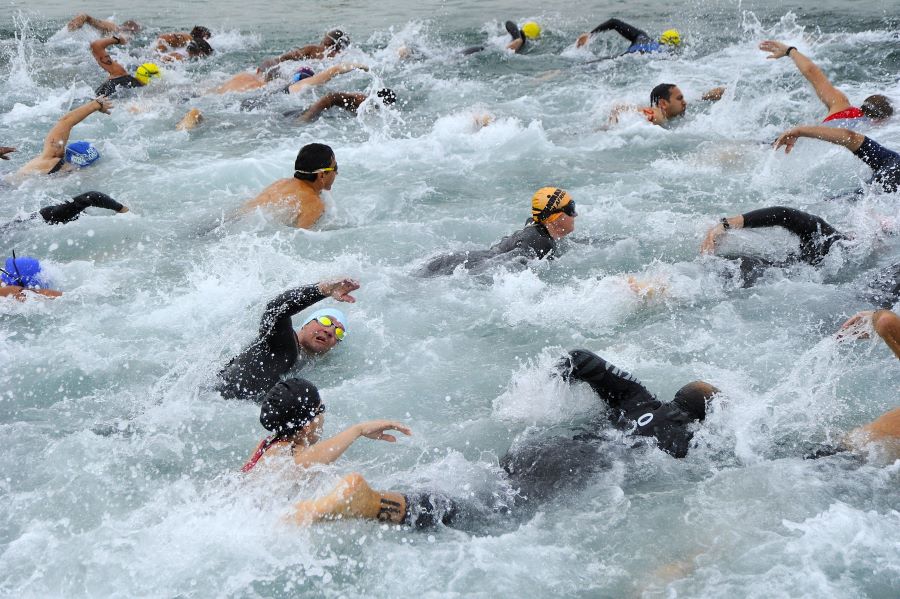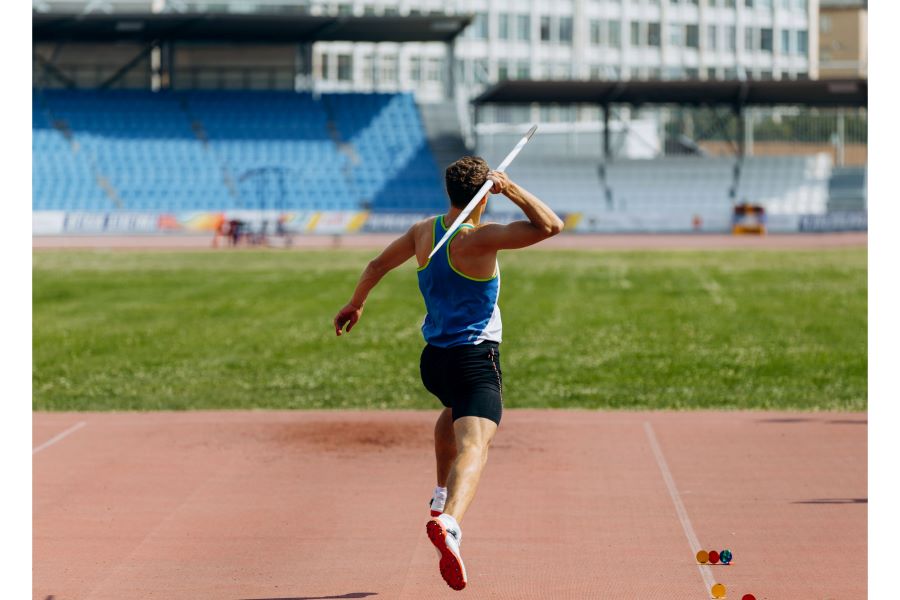This post may contain affiliate links. If you click an affiliate link and make a purchase, I may earn a commission. Also, as an Amazon Associate, I earn from qualifying purchases.--
Both triathlon and decathlon are just about the most challenging sports out there. But what are the differences between them?
Triathlon and decathlon have many differences between them, the main ones being the number of events, the techniques to learn in training, the location of events, how the winner is determined, and the kit required to compete.
Maybe you are considering your next sporting challenge and are looking to up the ante? In this article, I shall into everything you need to know about how triathlon and decathlon differ.

1. The Events Involved
The major difference between triathlon and decathlon is the number of events involved.
A triathlon will see you perform three events, while for a decathlon you will need to expand your scope even further to cover 10 events.
Triathlon involves a swim followed by a bike course, before completing the event with a run. The order of these stages does not change – it is always swimming, cycling, and a run.
Competitors will need to transition between the swim to the bike, and again from the bike to the run. A poor transition can ruin an otherwise good race, and hence why transitions are often looked on as triathlons’ fourth discipline.
A decathlon is made up of an eye-popping 10 different athletic events. These are (source):
- 100-meter race
- Long Jump
- Shot Put
- High Jump
- 400-meter race
- 110-meter hurdles
- Discus
- Pole Vault
- Javelin
- 1500 meter race
Both sports require endurance, combined with explosive bursts of speed and power. Although the individual events are quite different, both triathlon and decathlon offer a grueling challenge to competitors.
2. Accessibility
Triathlon is an accessible sport that caters to both men and women of all ages.
Decathlon is a men-only event at the major international tournaments, and although women do sometimes compete in decathlons, the equivalent tournament event for women is the heptathlon which consists of 7 events.
There are also numerous age group categories within triathlon, allowing you to test yourself against those of a similar age, a factor that can be a great motivator.
Most people will have swam, cycled, or run at some stage, and while increasing fitness levels to complete a triathlon is a challenge, the ‘how to’ of the events is not completely alien.
While you may have thrown the odd javelin or discus at school, or even ran a hurdles race now and again, they probably don’t come to mind automatically when considering new sporting challenges compared to the triathlon events.
Anybody can enter a triathlon, while you really need to be a member of an athletic club to compete in decathlons.
Decathlon is a highly specialized event, and access to the correct training and equipment is best through an affiliated athletic club. Of course, joining a triathlon club can also be highly beneficial to progress, but you can still enter triathlons if you prefer not to join a club.

3. Equipment
The events involved in triathlon and decathlon are different, and this difference is therefore reflected in the equipment and gear needed for each sport.
If we start with a triathlon, the basic equipment required is as follows:
- Swim wetsuit
- Swim hat
- Swim goggles
- Bike – a road bike will be fine for most people, or even a mountain bike when first starting
- Bike helmet
- Running shoes
These are the essentials for triathlon, but there are plenty of optional extras such as cycling gloves, cycling shoes, a race belt, and a triathlon suit.
This can all get a bit pricey, so sticking to a budget and only buying what you need and can afford is important. Here is a really useful youtube video that explains all about the essential equipment for triathlon:
The essentials to see you through the 10 events of a decathlon are:
- Running spikes
- Javelin
- Discuss
- Shot put
- Pole vault pole
The running spikes are particularly important as they are used for four of the events, and will be the one item you will tend to personally own.
4. Event Duration
The Olympic triathlon distance is the one most commonly competed over. This sees participants swim for 1.5 km, cycle for 40 km, and finish with a 10 km run.
Courses can vary in technical difficulty and elevation on the cycle and run routes, but the top athletes will be aiming to complete the event in under two hours. A newbie to triathlon will likely be nearer three hours on the course.
Each section of a triathlon follows on from each other with no breaks, just a transition from one event to the next to form one complete race on the day.
In contrast, the decathlon is played out over two days, with five events per day, culminating in a lung-bursting 1500-meter race.
Decathletes receive a break of at least 30 minutes between each individual event on both days of the competition. This provides some vital recovery time to refuel, massage tired muscles, stretch, warm back up, and go again.
5. Location
Decathlon is a track and field sport, that takes place in a stadium setting.
The decathlon needs a 400-meter running track, as well as a long jump pit, pole vault apparatus, and an infield for the throwing events. You may be able to do some training away from stadiums, but the competitions need stadium facilities.
The beauty of sports like triathlon is the freedom of location provided by not depending on stadium locations.
Triathlons are staged in some of the most stunning locations around the world. However, providing you have a suitable body of water for the swim and a suitable road course for the bike and run sections, you can stage a triathlon.
Indeed, this is what many towns and cities do across the globe, great for showing their local areas off to competitors and spectators alike.
The best and safest triathlons tend to be on closed roads where your full attention can be on the race rather than on passing traffic.
6. Different Triathlon Distances
Whereas the individual events which make up a decathlon are set in stone, this is not the case with triathlon.
Although the Olympic distance is the most common form of triathlon staged, triathlon can be staged over any distance. This makes life easier for local race organizers and helps make triathlons accessible to all.
However, that said, most triathlons tend to stick to the acknowledged distances for the different forms of the sport.
The following table shows the five most common triathlon events, with the distance for each of the individual events.
| Name | Swim | Bike | Run |
| Super sprint | 400 m | 10 km | 2.5 km |
| Sprint | 750 m | 20 km | 5 km |
| Olympic | 1500 m | 40 km | 10 km |
| Half Ironman | 1.9 km | 90 km | 21.1 km |
| Ironman | 3.8 km | 180 km | 42.2 km |
The super sprint and sprint distances offer an excellent gateway into triathlon for the beginner. The Olympic distance is the classic triathlon distance, while the Ironman represents the ultimate endurance challenge.
Anyone who can run a full marathon after a 1.9 km swim and a 90 km cycle gets my full respect and admiration.

7. Training
Training for any multi-event sport is a tough juggle, especially when planning around a full-time job.
You will need to make an honest assessment of how many hours you can devote to training each week before dividing up the events between those hours.
If you are strong in some events you may place more focus on weaker ones.
People training for triathlons with busy schedules may look to work bike or run elements into the day. This could include cycling to and from work or perhaps running to a swim session at the local pool.
Getting out on the bike for one long ride a week of at least an hour will help build stamina for the longest section of the triathlon.
In the decathlon, you have 10 events to juggle, each with its own particular technique to master. A sprint session on the athletics track will help build speed for the hurdles and long jump too, while a strength session in the gym will help for the throwing events.
However, you will still need to allocate specific sessions to work on techniques for each of the individual events.
A novice decathlete will probably start off with three days a week of training, working on their weakest event on one of those days.
However, they will also need to find time to work in the all-important strength conditioning work in the gym. As they progress, even more emphasis will be placed on strength conditioning and working on the technical side of the events.
8. Decathlon Is About Points
Triathlon has a nice and simple way for you to know who won. Whoever crosses the line first grabs the glory. There are no additional bonus points for whoever comes out of the swim first, or whoever is quickest on the bike. All that matters is who breaks the tape first at the finish of the run.
Triathletes will have access to their split times for their swim, bike, and run.
These are good for helping assess where you may need to tweak your training to focus on weaker events, but as far as a race is concerned it is the combined time that counts, as the quickest over the three events will also be the first across the finishing line.
A decathlon uses a more intricate points system to determine the winner.
Points are awarded according to performance in each of the ten events and whoever has the most points at the end is the winner. If you have the best time or longest distance in each event then you will earn the most points, but athletes rarely dominate all events.
The requirement of a calculator to work out who is leading a sport may not be to everyone’s taste, but it can create exciting finishes.
Going into the last event of a decathlon, athletes will be able to work out the approximate times they need to run the 1500 meters to earn the points to ensure a podium position.
An equation is used to determine points based on performance. Examples include.
| event | Time/Distance | Points Earned |
|---|---|---|
| 100 meter | 10 seconds | 1096 |
| Shot Put | 18 meters | 975 |
| 400 meters | 47 seconds | 958 |
| Discus | 55 meters | 975 |
| Javelin | 75 meters | 966 |
This is a flavor of how the decathlon points system works, with the current world record held by Kevin Mayer from France with an impressive 9,126 points (source).

9. Schedules
The main times the average athletics viewer will encounter decathlons is at the major events such as the Olympics and the World Athletics Championships, neither of which offers annual competition.
There will be national and regional decathlon titles up for grabs each year, but the decathlon will not be a part of the majority of track and field meets.
Outside of the Olympics and World Championships, the meeting held at Gotzis in Austria each year is the number one event for decathletes.
The Olympics is at the top of the tree for triathletes too, but the top triathletes’ competition schedule can be a busier one. The annual world series in triathlon has seven races, with top triathletes attending most of them.
For us mere mortals, triathlon is also a far more accessible sport with events held in local regions across the world and throughout the year. Decathletes will compete in single events at track meets to hone skills, but their moments to shine in the competition are far less than that of a triathlete.
Final Thoughts
Multi-event sports such as triathlon and decathlon offer grueling, yet rewarding challenges. While participants have to train for multiple events, there are a good many differences between the two sporting pursuits.
The main difference is decathlon involves 10 events to a triathlon’s three, yet this has a knock-on effect that sees areas such as training, location of events, rules, and equipment required all vary considerably between triathlon and decathlon.
